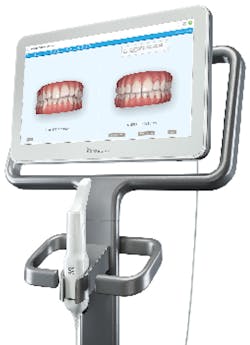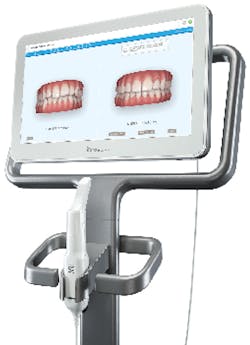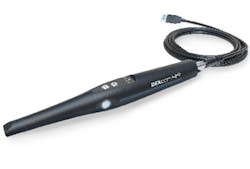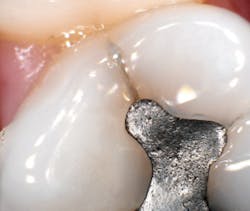Pearls for Your Practice
Invisalign Outcome Simulator 4.0 with the iTero Element 2 intraoral scanner from Align Technology
I have been in the intraoral scanning game for a long time. Around six or seven years ago, I took the plunge, and I have enjoyed my digital dentistry journey ever since. The keys to any intraoral scanner are workflows—the more integrated workflows, the better. With my old scanner, I had a workflow for using Invisalign. It was fairly basic and allowed me to just upload scans, more or less. What else do you need, right? Well, that’s what I thought until I got the iTero Element 2 intraoral scanner and experienced the Invisalign Outcome Simulator 4.0.
The Invisalign Outcome Simulator basically allows you and your team to run ClinCheck “Lite” on patients in the dental chair. Within a couple of minutes, you can be showing the patient virtual before-and-after images of what Invisalign can do for them. This is a vital tool for Invisalign providers on a couple of different fronts.
First, seeing is believing for patients. When they can visualize immediately what clear aligner therapy can do for them, it opens their minds to consider treatment. I have had several patients in a month who indicated zero interest in Invisalign initially but had changes of heart after seeing the simulation. We do an iTero Element 2 scan of the patient’s teeth as part of our new-patient visit. When I am discussing my examination findings with the patient, I use the Element 2 to show the patient his or her condition. If the patient has any orthodontic issues at all, I finish the discussion by running the Invisalign Outcome Simulator. Patients are often quite interested to see for themselves the difference Invisalign can make.
The other way the Invisalign Outcome Simulator is important in my practice is to help me figure out those cases that are what I call “in-betweeners.” These are cases that might appear, on first inspection, to be too tough for Invisalign, but once they’re in the software, they end up being a little bit easier. Previously, I would have immediately referred these cases out to ortho. The time costs—having to gather all the data and submit it to Invisalign—were not worth it.
Since the time investment with the iTero Element 2 is less than two minutes, now I always check and see what it looks like. I have already had one “in-betweener” case that ended up being pretty simple; the patient is currently in treatment. That is production that would have gone out the door but was kept in my practice by the iTero Element 2.
I have been thoroughly impressed with the Invisalign Outcome Simulator on the iTero Element 2. It is fast and easy to use, and it provides a rock-solid return on investment. This is one of the few features that is totally unique to a single intraoral scanner. Most things that can be done by one intraoral scanner can be done by most, but outcome simulation like this can be done only with an iTero scanner. It helps me close on Invisalign cases and keeps production in my office. Three-run moon shot home run for Align Technology!
DEXcam 4 HD intraoral video camera from DEXIS
Seeing really is believing for patients. It has been said a million times and remains as true today as the first day it was said. We must have tools in our practice to show patients the conditions of their mouths, so we can educate them on the best treatments for those conditions. There is simply no other way to do it. The tools you need to accomplish this vary based on your skills, technique, and practice setup.
I am a big fan of DSLR cameras. I cannot practice without one. There are some major disadvantages to them, though. They are big and cumbersome, and they require skill to use. When we use the DSLR camera in my office, it’s for a whole series of photos on a comprehensive-care patient. I can’t plan treatment for a complex case without those photos. But what about the things we see more frequently in the hygiene room that need to be discussed with the patient—the single-tooth things, such as cracks and old amalgams and such? How do we show patients those things? Intraoral cameras are a great way to do that. As far as intraoral cameras go, you can’t beat the quality of the DEXcam 4 HD from DEXIS.
DEXIS is certainly a flagship brand in the dental imaging world. DEXIS has been providing durable, high-quality imaging products to dental practices for decades. The DEXcam 4 HD is another amazing product in their portfolio. It has a 1.3 million–pixel CMOS sensor that takes crisp, close-up, vibrant images. Its durable glass optical lens is perfectly contoured to take distortion-free photos inside the mouth. DEXcam 4 HD is USB-powered, so it can be moved easily between treatment rooms when needed. Its durable design can hold up to that normal dental office wear and tear.
DEXcam 4 HD works with DEXcapture image-capture software. This software allows you to grab and store your images with ease and unlock some cool features of the DEXcam 4 HD, such as five-second video capture. The Compare mode allows you to show patients two different images at once. For example, you can show an old image of the same tooth or a contralateral healthy tooth.
I challenge my hygienists to take at least one intraoral image on every patient they see. That photo could show a cracked old amalgam, a resin breaking down, or even calculus on the lingual of the lower incisors. It doesn’t matter what they photograph and show, just that they use the intraoral camera to show the patient at least one thing. If you do this, the investment you made in your intraoral camera will pay off quickly. Triple into deep center field for DEXIS!



